Sgt. William Treseder had been out of the Marine Corps for a decade when he heard about the Marine Innovation Unit ― a Reserve unit that seeks to connect the Corps with the latest in innovation as it overhauls the force.
After his time on active duty, which included service in Iraq and Afghanistan, Treseder had graduated from Stanford University, worked in energy startups and co-founded BMNT, a company that helps U.S. national security agencies apply Silicon Valley technology. He thought his days in the Marine Corps were behind him.
But then Treseder, at the time on the Inactive Status List, met with innovation unit leadership and learned more about its mission.
Part of the impetus for the unit is Force Design 2030, the overhaul of the Marine Corps that seeks to modernize it in preparation for potential conflict with a near-peer, in particular the technologically advanced Chinese military. The unit is set up to help find the technology, broadly defined, that the Corps needs as it makes that shift.
RELATED

Treseder told Marine Corps Times he was “blown away” by the leaders and the chance to put force modernization ideas into practice.
“I was convinced that it was worth the effort to get back into the Marine Corps to bring to bear a lot of the skills and abilities and tapping into the relationships I’ve developed over the last decade-plus outside of the Marine Corps into the Marine Innovation Unit and the larger Marine Corps,” he said.
But before joining the Reserve unit, Treseder had to chop off his flowing blond locks. (That wasn’t the first time he had undergone a dramatic physical transformation for the Marine Corps — he had to lose approximately 100 pounds before he enlisted in 2001.)
Now, Treseder is the unit’s chief strategy officer, managing staffing for the unit’s initiatives — an unusual level of responsibility for an E-5. But, then again, it is an unusual unit.
Helping with the Corps’ overhaul
The idea behind the unit is that reservists, thanks to the expertise and connections they have developed in their civilian careers, can be uniquely situated to help modernize the active force.
“The Marine Corps comes to MIU when it has changes it needs to implement and it’s not sure how, and through MIU’s support, MIU Marines are able to propose other changes (if necessary) to the Marine Corps,” 1st Lt. Devin Nathan, a unit spokesman, wrote via email to Marine Corps Times.
When an active force unit comes across a thorny technological problem, that’s where the Marine Innovation Unit comes in. It might clue the unit into relevant civilian technology. It might connect the unit with another military unit or governmental agency that is working on a solution.
“We don’t always have the answers, but we can provide perspective and also connect individuals with the people that already have an answer,” Treseder said.
And then it typically backs off — it doesn’t have the resources to support a program long-term, said Sgt. Maj. Robert Lusk, its enlisted leader. The unit is made up of just a few hundred Marines and will remain that way for the next couple of years at least.

When the Reserve sought to experiment with small boats of the kind that the active force could one day use for shore-based operations, it was connections within the Defense Innovation Unit that helped the Reserve plan a rapid acquisition process for the boats, Reserve spokesman Lt. Col. Craig Thomas said. (The Defense Innovation Unit is the Defense Department’s agency that focuses on adopting commercial technology for military purposes.)
Now the Reserve is set to receive four or five commercially available watercraft in the spring — a faster timeline than most defense acquisitions.
“That wasn’t a real heavy lift,” Thomas added. “That was just MIU having the right connections and the right people to make things happen.”
The unit also is working with the active force on revamping Marine Corps personnel policies and systems. And the innovation unit puts those ideas into practice, according to Nathan. One of the goals of Talent Management 2030 is to recruit and retain Marines with deep technological expertise — like the reservists at the Marine Innovation Unit.
The unit’s command is rank-agnostic, meaning that the Marines’ skillsets and experience levels are more relevant than rank when it comes to deciding who leads a team. The Marines there do much of their work remotely, Nathan said.
The unit kicked off operations in March 2022, but its activation ceremony is scheduled for May 5.
Though it operates globally, the Marine Innovation Unit is headquartered in Newburgh, New York, out of Stewart Air National Guard Base, about an hour and a half’s drive from the talent pool of New York City. It’s also within the Hudson River Valley, home to an up-and-coming tech industry.
Its inception comes as the Marine Corps is relying on the Reserve not just as a smaller, part-time version of the active force, but also as a force that can contribute special talent in its own right.
The unit’s commanding officer, Col. Matthew Swindle, is also the chairman, CEO and founder of renewable energy company NLine Energy. And Lusk, the unit’s top enlisted Marine, is the director of information technology and security operations at OpenSpace, an artificial intelligence company.
A unit application says it seeks reservists with “significant professional experience or domain expertise” and “clearly exceptional talents.” One question on the application reads, “If you could make one change in the Marine Corps, what would it be and why?”
The unit accepts reservists with experience in startups, venture capital, management consulting and technology that has both civilian and military applications, according to the unit’s website. Artificial intelligence, cyber, energy, quantum computing, space and synthetic biology are just some of the fields of expertise that the unit looks for.
Retaining troops with cyber expertise in particular has proven a challenge across the services, amid competition from the private sector and other federal agencies. The Pentagon has poured millions into retention bonuses to keep sought-after cyber talent.
The unit doesn’t have an active-duty equivalent, according to Nathan. The Marine Corps Warfighting Laboratory, headquartered at Quantico, Virginia, also looks into technology offered by commercial vendors; the Marine Innovation Unit, as one of its duties, helps it find some of that dual-use technology.
The unit already has attracted significant interest from Marine reservists. One week after advertising 100 open jobs in the unit in January 2022, 300 applications had poured in from across the Reserve, Swindle told Marine Corps Times in June 2022. By June, it had received 975 applications.
In fiscal year 2022, the unit had about 132 staff. It’s authorized to grow to 270 this fiscal year and nearly 380 in fiscal year 2024, Swindle said.
“Personally, for the innovation space, more is not necessarily better,” Swindle said of the unit’s size. “Small teams that are task-organized to the problem you’re trying to solve have proven time over time to be a recipe for success, especially in the defense innovation space.”

Treseder said he was struck by the many conversations he had at the Marine Innovation Unit’s annual training in Quantico, Virginia, with his randomly assigned roommate, a Reserve major who is also the chief financial officer of a space technology startup. Despite his formidable expertise and qualifications, the major was humble and curious about Treseder’s work, Treseder recalled.
That’s true of other Marines in the unit, Treseder said.
“Most people with whom I interact — and I interact with a lot of PhDs — they’re very quick to get pulled off into the abstract world of whatever field they’re interested in,” Treseder said. “MIU subject-matter experts do not give themselves license to do that.”
“They are much more focused on the mission and much more focused on how things can be pulled back down to earth and brought to bear on behalf of the Marine Corps.”
Irene Loewenson is a staff reporter for Marine Corps Times. She joined Military Times as an editorial fellow in August 2022. She is a graduate of Williams College, where she was the editor-in-chief of the student newspaper.








